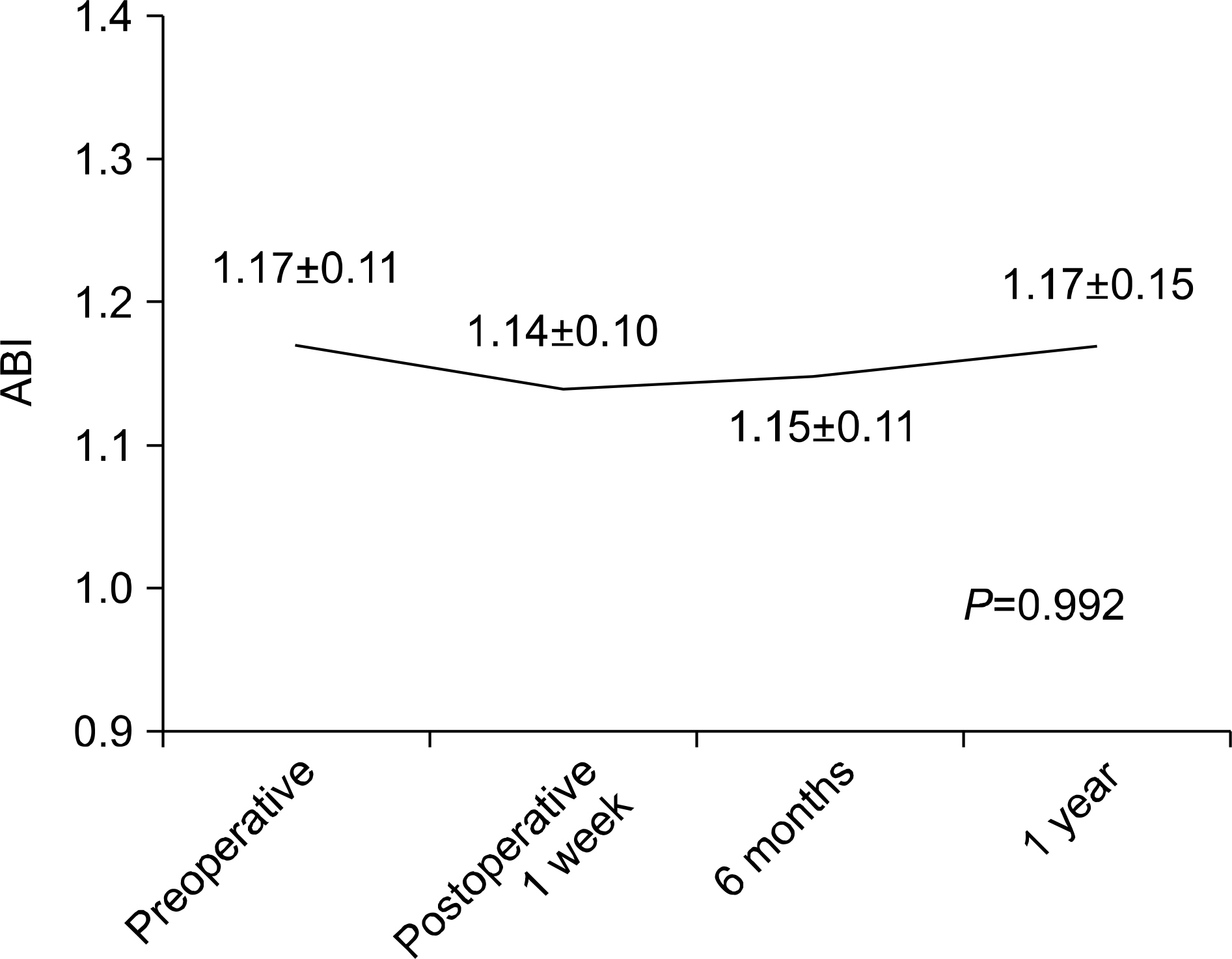J Korean Soc Transplant.
2014 Dec;28(4):200-203. 10.4285/jkstn.2014.28.4.200.
Alteration of Ankle-Brachial Index after Kidney Transplantation
- Affiliations
-
- 1Department of Surgery, Chonnam National University Medical School, Gwangju, Korea. choisjn@chonnam.ac.kr
- KMID: 1941314
- DOI: http://doi.org/10.4285/jkstn.2014.28.4.200
Abstract
- BACKGROUND
A steno-occlusive disease of the iliac artery can mimic renal vascular hypertension, and is an important cause of renal dysfunction in renal transplant recipients. We assessed the alternation of postanastomotic arterial blood flow of lower extremities by ankle-brachila index (ABI).
METHODS
We analyzed 50 patients who underwent kidney transplantation between March, 2010 and November, 2012 at Chonnam National University Hospital. This study was performed prospectively and case selection by renal transplantation patients who got first operation on right iliac fossa. All operational procedures were end to side anastomosis of the external iliac artery to the renal artery. We measured and compared the preoperative and postoperative (1 week, 6 months, 1 year) ABI. We analyzed the diameter of the recipient external iliac artery and renal artery of the transplanted kidney.
RESULTS
Among 50 patients, 34 were male (68%) and 16 were female (32%). The mean age of recipients was 44.37+/-11.42 years. The mean preoperative ABI at the right lower extremity was 1.17+/-0.11, postoperative 1 week, 6 months, and 1 year was 1.14+/-0.10, 1.15+/-0.11, 1.17+/-0.15, respectively. Alternation of preoperative ABI and postoperative 1 week, 6 months, and 1 year was P=0.331, P=0.864, and P=0.992, respectively.
CONCLUSIONS
Alternation of ABI on the ipsilateral lower extremity was not significant in renal transplanted recipients. We recommend a long-term study with more cases.
MeSH Terms
Figure
Reference
-
References
1). Moon I, Kim Y, Park J, Kim S, Koh Y. Various vascular procedures in kidney transplantations. Transplant Proc. 1998; 30:3006.
Article2). Matheus WE, Reis LO, Ferreira U, Mazzali M, Denardi F, Leitao VA, et al. Kidney transplant anastomosis: internal or external iliac artery? Urol J. 2009; 6:260–6.3). El-Sayed HF. Bypass surgery for lower extremity limb salvage: vein bypass. Methodist Debakey Cardiovasc J. 2012; 8:37–42.
Article4). Merkus JW, van Asten WN, Hoitsma AJ, Buskens FG, Koene RA, Skotnicki SH. Iliac artery stenosis after kidney transplantation. Acta Chir Belg. 1993; 93:242–8.5). Etemadi J, Rahbar K, Haghighi AN, Bagheri N, Falaknazi K, Ardalan MR, et al. Renal artery stenosis in kidney transplants: assessment of the risk factors. Vasc Health Risk Manag. 2011; 7:503–7.6). Manfredini F, Malagoni AM, Manfredini R. Ankle brachial pressure index: faulty or overused? Angiology. 2013; 64:89–92.7). Lin JS, Olson CM, Johnson ES, Whitlock EP. The ankle-bra-chial index for peripheral artery disease screening and cardiovascular disease prediction among asymptomatic adults: a systematic evidence review for the U.S. Preventive Services Task Force. Ann Intern Med. 2013; 159:333–41.
Article8). Wolfe RA, Ashby VB, Milford EL, Ojo AO, Ettenger RE, Agodoa LY, et al. Comparison of mortality in all patients on dialysis, patients on dialysis awaiting transplantation, and recipients of a first cadaveric transplant. N Engl J Med. 1999; 341:1725–30.
Article9). Hariharan S, Johnson CP, Bresnahan BA, Taranto SE, McIntosh MJ, Stablein D. Improved graft survival after renal transplantation in the United States, 1988 to 1996. N Engl J Med. 2000; 342:605–12.
Article10). Djamali A, Premasathian N, Pirsch JD. Outcomes in kidney transplantation. Semin Nephrol. 2003; 23:306–16.
Article11). Kim YS, Kim SI, Kim MS, Huh KH, Ju MK, Joo DJ, et al. Evaluation of independent risk factors affecting renal allograft survival by transplant era. J Korean Soc Transplant. 2012; 26:178–87. (김유선, 김순일, 김명수, 허규하, 주만기, 주동진, 등. 신장이식에 영향을 미치는 위험인자의 시대별 변화양상. 대한이식학회지 2012;26: 178–87.).
Article12). Aboyans V, Criqui MH, Abraham P, Allison MA, Creager MA, Diehm C, et al. Measurement and interpretation of the ankle-brachial index: a scientific statement from the American Heart Association. Circulation. 2012; 126:2890–909.13). Campean V, Neureiter D, Varga I, Runk F, Reiman A, Garlichs C, et al. Atherosclerosis and vascular calcification in chronic renal failure. Kidney Blood Press Res. 2005; 28:280–9.
Article14). Nishioka T, Akiyama T, Nose K, Koike H. Organic and functional evaluation of atherosclerosis in renal transplant recipients. Hinyokika Kiyo. 2007; 53:681–6.15). Covic A, Goldsmith DJ, Gusbeth-Tatomir P, Buhaescu I, Covic M. Successful renal transplantation decreases aortic stiffness and increases vascular reactivity in dialysis patients. Transplantation. 2003; 76:1573–7.
Article16). Criqui MH, Denenberg JO, Bird CE, Fronek A, Klauber MR, Langer RD. The correlation between symptoms and noninvasive test results in patients referred for peripheral arterial disease testing. Vasc Med. 1996; 1:65–71.
Article
- Full Text Links
- Actions
-
Cited
- CITED
-
- Close
- Share
- Similar articles
-
- Association between Aging and Changes in the Ankle-Brachial Index after Exercise in Patients with Chest Pain
- Prognostic Factors of Wound Healing after Diabetic Foot Amputation; ABI, TBI, and Toe Pressure
- False Normalization of Ankle Brachial Index: A Case of Lower Extremity Peripheral Arterial Disease with Normal Ankle-Brachial Index
- Ankle-brachial blood pressure differences in the beach-chair position of the shoulder surgery
- Aortoiliac Occlusive Disease as a Cause of Allograft Kidney Dysfunction and Refractory Hypertension


